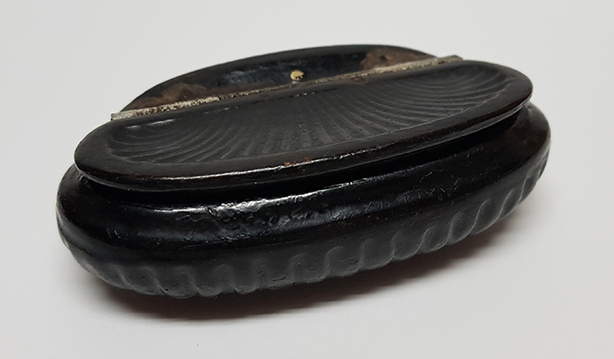Pocket treasures

Un texte de Heather Darch
Paru dans le numéro Hiver/Winter 2021-2022
Publié le : 30 novembre 2021
Dernière mise à jour : 30 novembre 2021
Family lore says that Reynolds carried his black lacquered, papier-mâché snuff box throughout his time as a soldier and prisoner-of-war and as a settler in Missisquoi County. It was his treasured object and survived the travails of war and displacement.
What did your ancestors carry in their pockets? Was it loose change, a thimble, door keys? Loyalist Benjamin Reynolds carried a small shell-shaped snuff box in his pocket. Snuff was finely ground tobacco; often laced with herbs, aromatic oils, or spices and sometimes coloured with red ochre and white chalk. It was inhaled or “snuffed” up the nose delivering a hit of nicotine to the user and leaving the bouquet of spices in the nose.
Snuff-taking was a widespread habit during the 18th to mid-19th centuries. While the practice of snuffing tobacco was originally used by indigenous cultures, the first documented reference in 1493 noted Haiti’s Taíno people inhaling dried tobacco powder. England’s Queen Elizabeth I condemned all forms of tobacco and her successor, James I, imposed taxes and restricted its cultivation. During the mid-17th century reign of Charles II however, tobacco was embraced and by the end of the century, all of Europe was snuff-mad. Amongst the nobility, snuff had supplanted smoking.
The snuff box became an essential and very personal possession. Boxes were given as gifts of friendship and love. They were designed in a variety of shapes and materials to appeal to every taste and pocketbook including jewel encrusted gold and silver boxes to those made of tortoiseshell, ivory, porcelain, horn and papier-mâché. They were designed small to fit the pocket and for immediate consumption, carrying a day or two’s supply, and in large table-top containers for communal use.
Boxes bore images of cherubs, landscapes, hunting scenes and florals. Boot-shaped boxes, horns, shells, hands, animals, bicorn hats and even coffins were fashionable. They were decorated in motifs ranging from political to spiritual and even to the risqué.
There was an etiquette amongst the upper classes when taking snuff and a practiced handling with exaggerated mannerisms was a sign of gentility. Using the box skillfully could enhance a person’s talents in conversation and women who manipulated a snuffbox with elegance drew attention to their beauty and grace.
Critics early on recognized the addictive qualities of snuff. Puritan leader Cotton Mather (1663-1728) of Massachusetts said:
How shameful a thing it is, for People of Reason to confess that they can’t live easily half an Hour together, without a Delight so sensual, so Trivial, so very Contemptible, as that of Tickling their Olfactory Nerves a little ? And even bury themselves alive, in pungent Grains of titillating Dust…A very just Motto for the Snuff-box might be, A LEADER TO THE COFFIN.
For the average person, the taking of snuff was not accompanied by the frivolous manners of the rich. And while the snuff box itself was a practical possession to keep powder dry, it was nonetheless, a valuable personal object. Benjamin Reynolds (1740-1831) and his wife Mary Baker (1743-1817), were early Loyalists in Missisquoi County. Their allegiance to Britain during the American Revolution, cost them their farm as well as their house and personal belongings.
In 1777, Reynolds joined the 1st Battalion of the King’s Royal Regiment of New York. He was captured that same year following the defeat of General Burgoyne at Saratoga. Then he was held prisoner for five months and then sold into servitude for an additional nine months. His wife and their five children were forcibly evicted from their home and along with other displaced families, they made their way into one of the refugee camps located at Chambly, Sorel or Saint Jean-sur-Richelieu, Quebec.
By 1781, Reynolds was reunited with his family and was stationed at the Upper Yamaska Blockhouse (Saint-Césaire). In 1787, he petitioned the government to settle at Missisquoi Bay. His name appears on an Oath of Allegiance sworn at the Bay on April 30, 1795. And by the following year, his family was settled in Frelighsburg. Family lore says that Reynolds carried his black lacquered, papier-mâché snuff box throughout his time as a soldier and prisoner-of-war and as a settler in Missisquoi County. It was his treasured object and survived the travails of war and displacement.
One can imagine that his snuff box, now housed in the collection of the Missisquoi Museum, was a source of comfort in his darkest days. Snuff boxes were kept in pockets close to the body as warm snuff had a more fragrant scent. It is likely that he opened his box, smelled its aroma and held it tight in his hand. Clinging to hope and to the only possession he owned in the world.
Heather Darch
Sources :
The Loyalists of the Eastern Townships of Quebec ; The National Archives of the UK ; Kew, Surrey, England ; American Loyalist Claims, Series II ; Class : AO 13 ; Piece : 079 ; Alphabetical Index to the Land Grants by the Crown in the province of Quebec from 1763 to 31st December 1890, Quebec Family History Society, 2005 ; History of the Snuff Box https ://www.acsilver.co.uk/shop/pc/snuff-box-history-d130.htm ; Rita Reif, “When the right snuff box really mattered,” https ://www.nytimes.com/1990/06/03/arts/antiqueswhen-the-right-snuff-box-really-mattered.html ; Madeline Siefke, “Colonial New England Silver Snuff, Tobacco and Patch Boxes : Indices of Gentility,” https ://www.colonialsociety.org/node/1357

